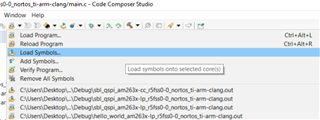Other Parts Discussed in Thread: UNIFLASH, , LP-AM263
Tool/software:
I am having issues booting the default sbl_qspi.release.tiimage SBL image from the SDK in either QSPI (4S) or QSPI (1S) mode on my custom board.
I can run the QSPI tests built on CCS using JTAG ok.
I program the flash using uart_uniflash.py and default sbl_qspi image with switch settings for UART boot SOP0=0, SOP1=1, SOP2=1, SOP3=1 but when I change the switch settings to SOP0=1, SOP1=0, SOP2=1, SOP3=1 (QSPI (1S)) and power cycle I do not see "Starting QSPI Bootloader ..." on the console of my PC. However with my scope I can see activity on the clock and data line into micro at boot from the flash device.
(1) Tests loaded using JTAG using custom board with -
Processor = AM2634COKFHMZCZRQ1
SDK = mcu_plus_sdk_am263x_09_02_00_55
Flash = S25FL128SAGNFI010
CCS = 12.7.1.00001
[Cortex_R5_0] [QSPI Flash Diagnostic Test] Starting ...
[QSPI Flash Diagnostic Test] Flash Manufacturer ID : 0x1
[QSPI Flash Diagnostic Test] Flash Device ID : 0x2018
[QSPI Flash Diagnostic Test] Executing Flash Erase on first block...
[QSPI Flash Diagnostic Test] Done !!!
[QSPI Flash Diagnostic Test] Performing Write-Read Test...
[QSPI Flash Diagnostic Test] Write-Read Test Passed!
[QSPI Flash Diagnostic Test] Error in reading SFDP Table or SFDP not supported by Flash !!!
All tests have passed!!
[Cortex_R5_0] [QSPI Flash Transfer Test] Starting ...
[QSPI Flash Transfer Test] Executing Flash Erase on first block...
[QSPI Flash Transfer Test] Performing Write-Read Test...
All tests have passed!!
(2) Flashing default sbl_qspi.release.tiimage from SDK prebuilt. Flash and verification OK, but nothing on console when power cycle with switch settings on QSPI (1S) boot or QSPI (4S). I was expecting "Starting QSPI Bootloader ...".
c:\ti\mcu_plus_sdk_am263x_09_02_00_55\tools\boot>python uart_uniflash.py -p COM11 --cfg=default_sbl_qspi.cfg
Parsing config file ...
Parsing config file ... SUCCESS. Found 2 command(s) !!!
Executing command 1 of 2 ...
Found flash writer ... sending sbl_prebuilt/am263x-lp/sbl_uart_uniflash.release.tiimage
Sent flashwriter sbl_prebuilt/am263x-lp/sbl_uart_uniflash.release.tiimage of size 42129 bytes in 4.0s.
Executing command 2 of 2 ...
Command arguments : --file=sbl_prebuilt/am263x-lp/sbl_qspi.release.tiimage --operation=flash --flash-offset=0x0
Sent sbl_prebuilt/am263x-lp/sbl_qspi.release.tiimage of size 227181 bytes in 24.05s.
[STATUS] SUCCESS !!!
All commands from config file are executed !!!


